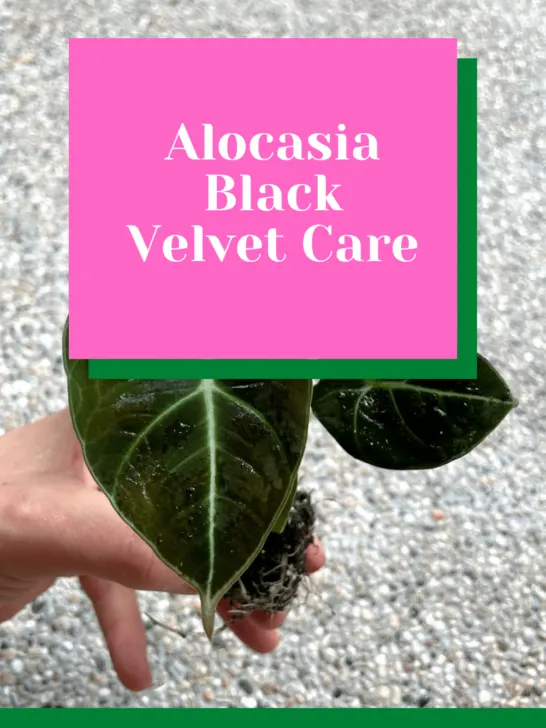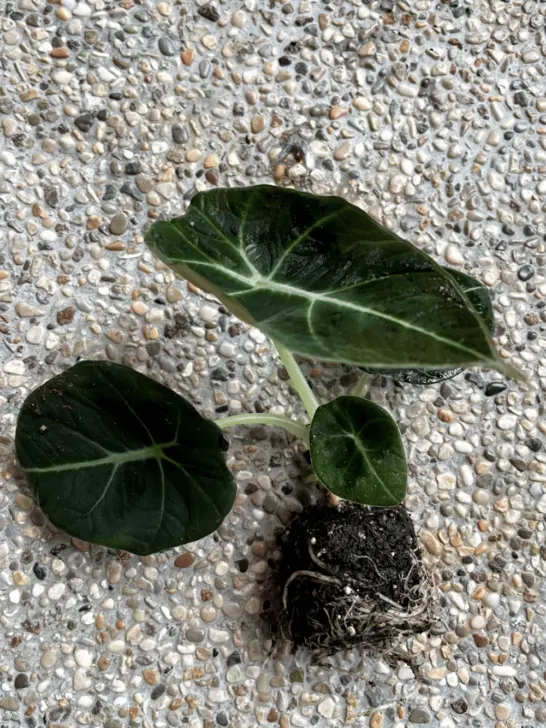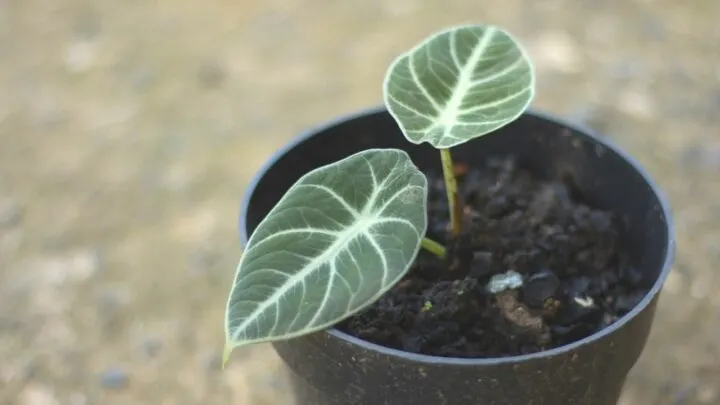The Alocasia Black Velvet – also known as the Alocasia reginula – is a miniature Alocasia known for its stunning foliage. It gets its name from the dark velvety appearance of the leaves, which are offset by the striking white veins. It is native to Sabah state in Malaysia.
Alocasia is a genus of 80 tuberous species, according to NC State Extension.
Like many variants of Alocasia, the ‘Black Velvet’ needs a unique care regimen and can sometimes be a little particular. The good thing is that once you know the main aspects, you can manage this beautiful little plant just fine.
Alocasia reginula Takeaways
| Species | Alocasia reginula |
| Synonyms | Jewel Alocasia, Black Velvet |
| Family | Araceae |
| Genus | Alocasia |
| Growth | Compact, Clumping |
| Height | 1 feet |
| Width | 1 feet |
| Soil | Well-draining soil mix |
| Watering | Every 7-14 days |
| Light | Bright Indirect |
| Temperature | 65-75 °F (18-24 °C) |
| Humidity | 60-80% |
| Fertilizer | Fertilize monthly in spring and summer |
| Propagation | By division |
| Toxicity | Toxic to animals such as cats and dogs, and humans. Contains calcium oxalate crystals. Can cause mouth pain, nausea, vomiting, and diarrhea. |
Table of Contents
Alocasia Black Velvet Care
The Alocasia Black Velvet grows best in a temperature range between 70-80 degrees Fahrenheit (21-27 degrees Celsius). The ideal humidity lies at 65%. The soil will need to be well draining and needs to retain moisture. Water lightly once a week when the top 2-3 inches of soil are dry. Bright indirect sunlight is best.

Alocasia Black Velvet Care Guide
Light
Found in the lush rainforests of Asia, the Alocasia ‘Black Velvet’ is specifically native to the Borneo jungle environment.
In the wild, it is exposed to dappled or shaded light under the canopies. You will want to recreate this environment as best you can for your ‘Black Velvet’ Alocasia.
The best way to do this in the home environment is to place it in a sunny room but away from the window so that it receives bright but indirect sunlight.
Be careful of direct light or how the sun approaches your windows at different times of the year, as any sudden exposure can damage the leaves.
Watering
For watering, the same principles must be applied to ensure the Alocasia ‘Black Velvet’ feels at home. You want to recreate the natural environment. For this tiny plant, this means being watered lightly but regularly.
This is important to keep the soil constantly moist without becoming waterlogged. You can achieve this by ensuring you are watering lightly and holding back if you feel the soil is becoming dense with water.
Soil
The soil conditions will also need to support this exotic plant’s particular needs. You need soil that can retain moisture but without becoming waterlogged. Make your mix to suit your Alocasia ‘Black Velvet’ by combining standard potting soil with peat or sand.
That will give it the consistency it needs to facilitate good drainage. This is key, as while the Alocasia species enjoys moist soil, it can also be susceptible to root rot if exposed to excessive water for prolonged periods.
Temperature
The Alocasia ‘Black Velvet’ craves warmth, especially in summer. So, temperatures around 70 degrees Fahrenheit are ideal. In the summer, it wants to be in an environment approaching 80 degrees Fahrenheit.
Be careful with lower temperatures below 60 degrees Fahrenheit (16 degrees Celsius); the plant will go dormant. Extremely low temperatures will damage its growth.
Flowers
The Alocasia ‘Black Velvet’ occasionally flower, although this is not the main reason for purchasing the plant. The Alocasia species is prized for its beautiful leaves, and none are perhaps as striking as those on the Black Velvet.
They are so dark they are almost purple; the leaves are the key feature. So flowering is usually a side event, and the flower is usually unspectacular anyway.
Many Alocasia owners remove the flower at the first sign, as it can cause the plant to divert energy from the leaves for a while.
Humidity
One of the key factors you need to monitor if you have an Alocasia ‘Black Velvet’ is your home’s humidity level.
This tropical plant is home in the rainforests, so it requires high humidity levels. This means levels of at least 60%, but ideally, the plant is most comfortable at around 70% humidity.
This can be a challenge for you, especially during the winter, as the air usually becomes quite arid if you use radiators.
Help your plant by placing it in a more humid environment – such as the bathroom – and mist the leaves regularly. If it is struggling, you may need to consider a humidifier.
Propagation
The Alocasia ‘Black Velvet’ is best propagated by the division of the underground rhizome system. These will grow from the mother plant to around 20 centimeters below the ground in the wild.
Of course, your containerized Black Velvet will likely have a smaller rhizome system, and it is from these that you will need to propagate.
It is also possible to propagate the Alocasia ‘Black Velvet’ from seeds. However, this is a slow process. The rhizome splitting method will give you faster results.
To begin, ensure it is the right time for propagation. Doing it in the winter, when the plant is dormant, will not bring any success. Wait until spring is showing its first signs, then get ready.
Take your Alocasia ‘Black Velvet’ from its pot and gently shake off the extra soil around the roots. At this point, you should take the opportunity to check the root system of the mother plant is in good condition and not showing any signs of fungal infections or entanglement.

Next, inspect the rhizome system. These look like clumps of ginger, and you will be able to see where the best place is to cut them. Use a clean knife or cutting instrument – and ensure you are wearing gloves – to remove the rhizome of your choice.
Next, it is time to plant it. You need a potting mix to create the conditions the new plant needs to thrive. Mixing standard potting mix with coco coir is a good option.
Once ready, place your rhizome into the soil and give it a light drink. Place your new plant in an area that gets bright but indirect sunlight. Then, follow the same regimen you have for the mother plant.
Repotting
It is good practice, once a year, to check your plant to see if it needs to be repotted. Even if it doesn’t, it is a good opportunity to check the soil and the root system to verify if the plant is getting cramped.
Lift it out gently, and if the roots are restricted or poking through the drainage, it is time to graduate your plant up a pot size.
Growth
The Alocasia ‘Black Velvet’ is a little mini Alocasia! Its maximum height will not exceed 20 inches (50 centimeters), although 12 inches (30 centimeters) is the norm. Leaves can reach about 3 – 4.7 inches (8 – 12 centimeters).
So you won’t find the Black Velvet taking over your living space. If you have a bigger room to fill, such as one with vaulted ceilings or a large hall, the Alocasia ‘Dark Star’ may be one to consider.
Fertilizer
Fertilize Alocasia Black Velvet monthly in spring and summer and reduce fertilizing in autumn and winter to every other month.
Dilute regular houseplant fertilizer to 1/2 its strength.
Alocasia Black Velvet Toxicity
The Alocasia ‘Black Velvet’ is toxic to both animals and humans. Keep it away from any animal or child likely to try to explore it. When handling the plant, especially during propagation, wear gloves.
Watch out for signs and symptoms of inhalation or exposure. This includes burning or tingling, swelling of the airways, and in extreme cases, death. If you think there has been exposure in your household, contact a vet or doctor promptly.

Common Problems with the Alocasia Black Velvet
Following this care guide will take a long way to keep your Alocasia ‘Black Velvet’ happy. But, the plant can be known to be a little fussy, so you know how to address any problems quickly.
Luckily, most of them are easy to fix and cause only temporary damage to the leaves. But, since the leaves are the prize feature, this can upset collectors. Let’s look at the main issues the Alocasia ‘Black Velvet’ can experience and how to address them.
Crispy Leaves
Crisping or curling leaves can indicate either under-watering or low humidity. Check firstly that the soil is maintaining a degree of moisture. If not, you need to increase your watering regimen. If the soil is indeed moist enough, check on your home’s humidity levels.
Levels under 60% are too low, meaning the plant cannot replace the moisture lost through the leaves. Try misting the leaves daily or moving the plant to a more humid location, such as a bathroom.
Low light levels
The Alocasia ‘Black Velvet’, like other Alocasia variants, will ‘search for light.’ If it is not getting adequate levels, it will start to droop down at the stem to search for it.
This can make your plant look distorted and sad. Make sure you have your Alocasia ‘Black Velvet’ as close to the window as possible without it being in direct sunlight.
Rot and Overwatering
If your plant is wilting, looking insecure in the pot , or soft around the base, check for root rot. This is a problem common to many plants and is caused by too much water content in the soil.
This seals up the air pockets and saturates the roots so they don’t absorb water. The damp environment gives rise to fungal infections, which, if not treated properly, will likely result in the death of the plant.
Ensure the soil is moist but not saturated, that there is no water pooling, and that you do not let the plant sit in a plate of water.
Alocasia Black Velvet Insects and pests
The Alocasia ‘Black Velvet’ can also get its fair share of unwanted visitors. Mealybugs are one of the most common pests on the planet.
They breach the protective outer layer of the plant and feast on the plant’s nutrients. Besides causing the leaves to look unsightly, they can also spread infections.
If you notice white spots forming on the leaves, you should also check for spider mites. Take action to remove any signs of infestation. You can start by trying to hose or rinse them off or using a soapy water mix. If that doesn’t work, you may need to use a light pesticide.
Frequently Asked Questions
Why are the leaves on my Alocasia Black Velvet crispy?
This is usually related to the humidity levels in the home. The leaves lose water during the day at different rates, depending on the room’s humidity.
If the environment is particularly arid – for the Alocasia, arid means any levels less than 60% – then the roots won’t be able to replace the water lost quickly enough. Check the humidity levels and rectify if necessary; try misting the leaves and ensure the plant gets adequate water.
Why is my Alocasia ‘Black Velvet’ not flowering?
If you are looking for a flowering plant, the Alocasia ‘Black Velvet’ might not suit you. While the plant does flower occasionally, the display is often unspectacular and often occurs at the detriment of the leaves.
For that reason, many Alocasia lovers prefer the plant not to flower. Flowering will happen when the plant is in optimal conditions but it is not guaranteed. So, don’t hang your hat on this plant bringing you flowers; focus on the beautiful leaves as the main attraction instead.
Conclusion About Alocasia Black Velvet Care
The Alocasia Black Velvet does best in bright indirect light and temperatures between 70-90 °F (21-26 °C).
Use a well-draining aroid soil that holds moisture well and water lightly once the top 2-3 inches of soil are dry. Fertilize monthly in spring and summer and every two months in winter and autumn.

Daniel has been a plant enthusiast for over 20 years. He owns hundreds of houseplants and prepares for the chili growing seasons yearly with great anticipation. His favorite plants are plant species in the Araceae family, such as Monstera, Philodendron, and Anthurium. He also loves gardening and is growing hot peppers, tomatoes, and many more vegetables.


